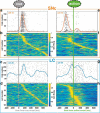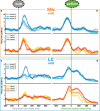Noradrenaline and dopamine neurons in the reward/effort trade-off: a direct electrophysiological comparison in behaving monkeys
- PMID: 25995472
- PMCID: PMC6795183
- DOI: 10.1523/JNEUROSCI.0454-15.2015
Noradrenaline and dopamine neurons in the reward/effort trade-off: a direct electrophysiological comparison in behaving monkeys
Abstract
Motivation determines multiple aspects of behavior, including action selection and energization of behavior. Several components of the underlying neural systems have been examined closely, but the specific role of the different neuromodulatory systems in motivation remains unclear. Here, we compare directly the activity of dopaminergic neurons from the substantia nigra pars compacta and noradrenergic neurons from the locus coeruleus in monkeys performing a task manipulating the reward/effort trade-off. Consistent with previous reports, dopaminergic neurons encoded the expected reward, but we found that they also anticipated the upcoming effort cost in connection with its negative influence on action selection. Conversely, the firing of noradrenergic neurons increased with both pupil dilation and effort production in relation to the energization of behavior. Therefore, this work underlines the contribution of dopamine to effort-based decision making and uncovers a specific role of noradrenaline in energizing behavior to face challenges.
Keywords: choice; decision; locus coeruleus; motivation; pupil; substantia nigra.
Copyright © 2015 the authors 0270-6474/15/357866-12$15.00/0.
Figures






Comment in
-
Noradrenaline and dopamine: sharing the Workload.Trends Neurosci. 2015 Aug;38(8):465-7. doi: 10.1016/j.tins.2015.07.001. Epub 2015 Jul 14. Trends Neurosci. 2015. PMID: 26183088
References
Publication types
MeSH terms
LinkOut - more resources
Full Text Sources
Miscellaneous
